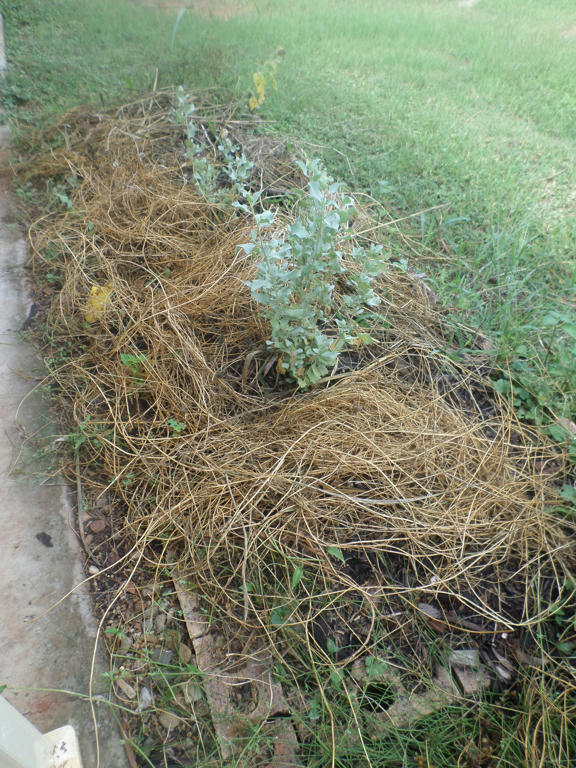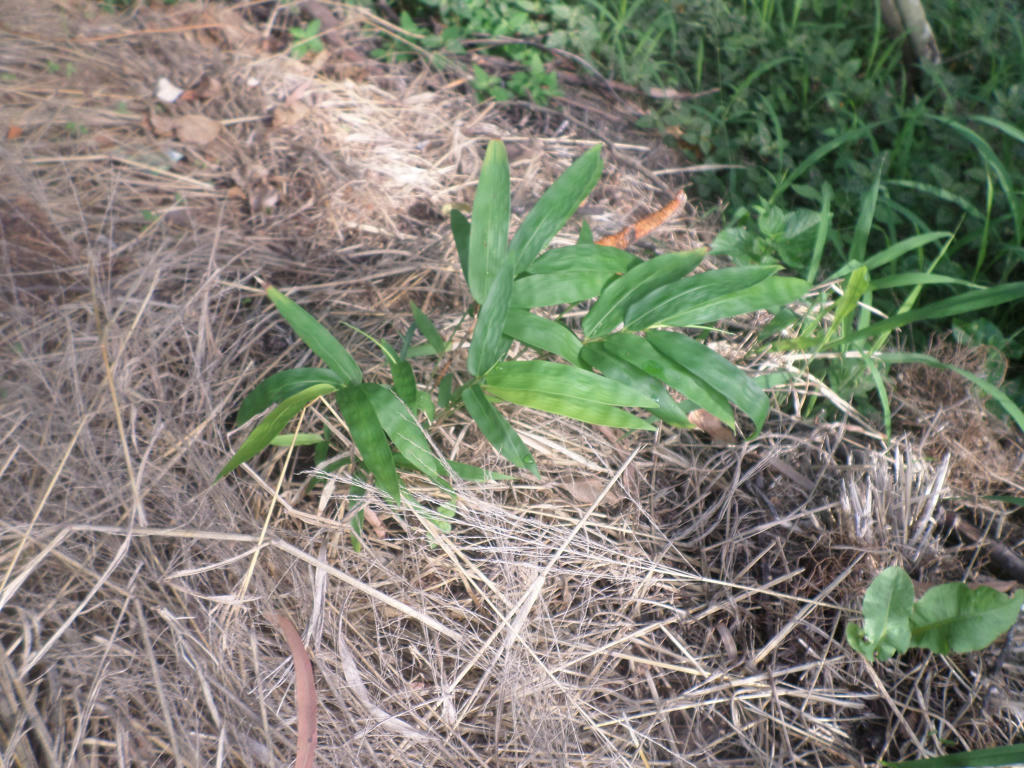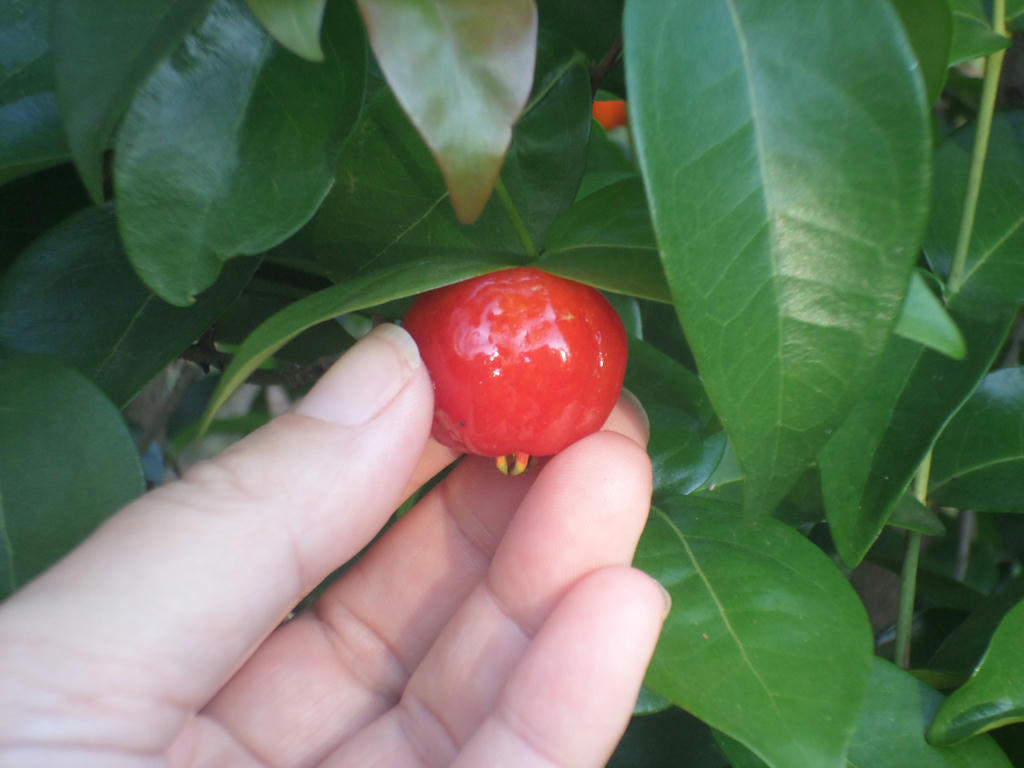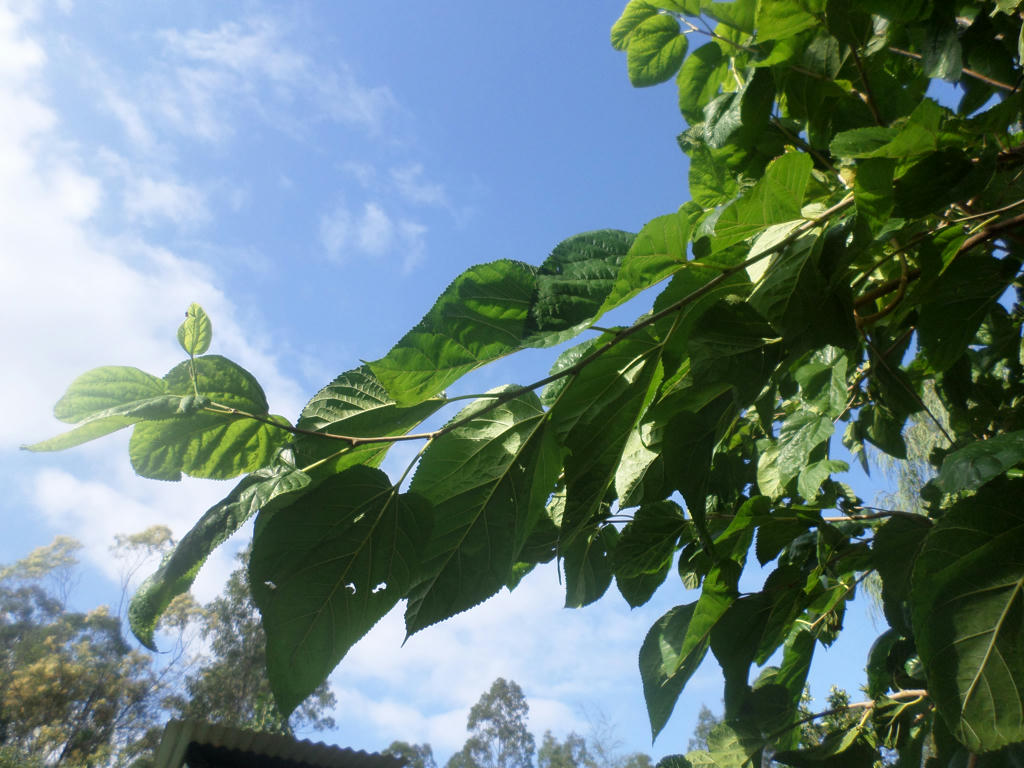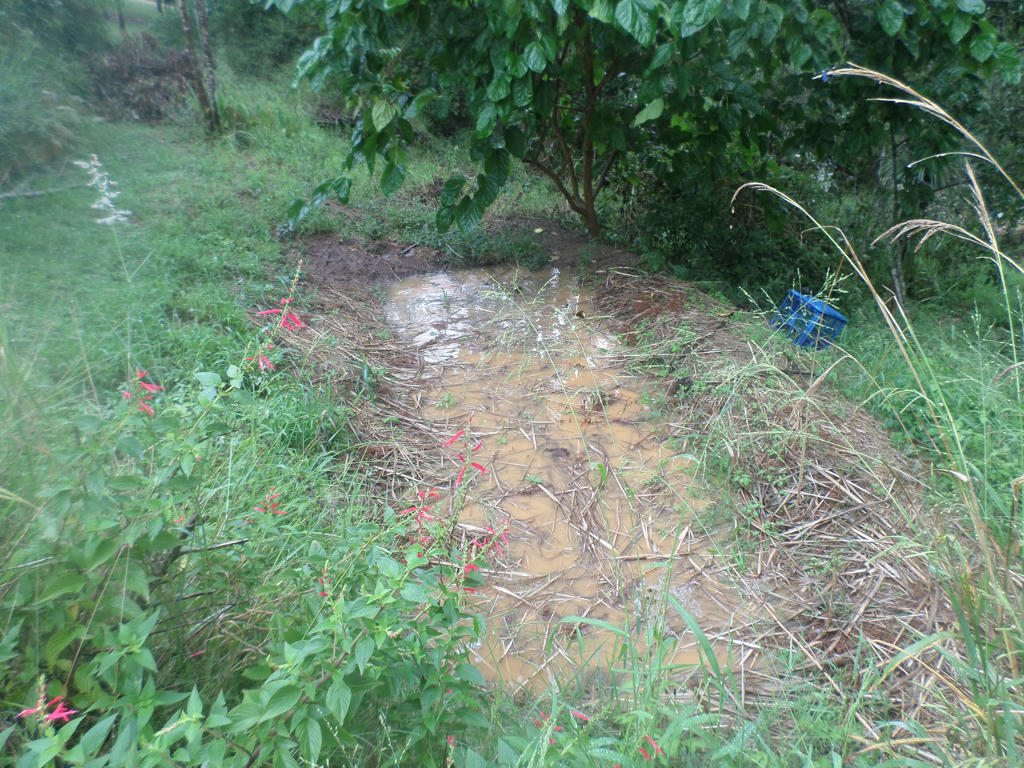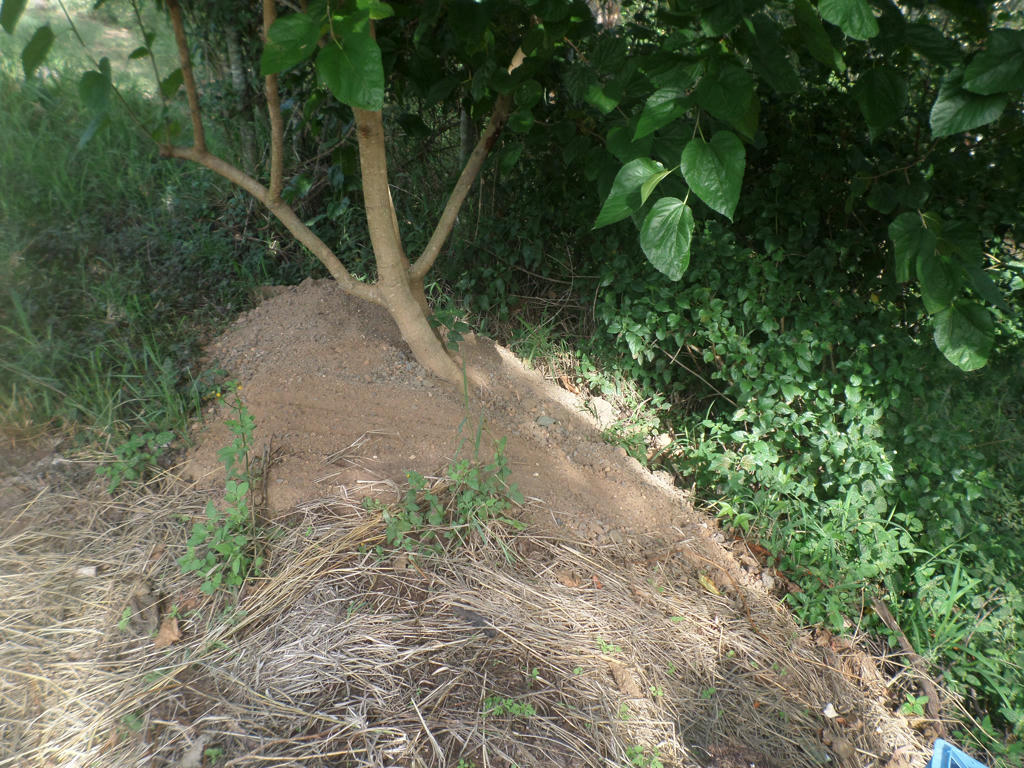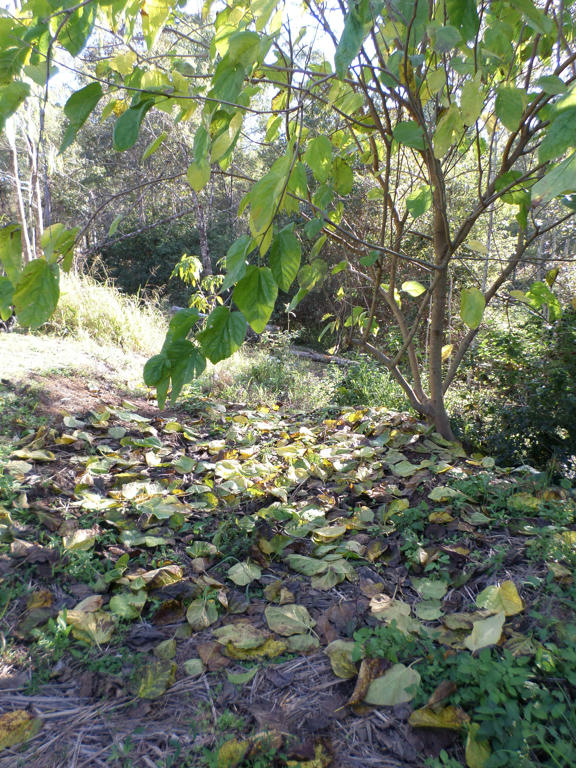Buying mulch gets expensive to cover acreage, but it's also, somewhat unnecessary. As land can grow plenty of plants to substitute for mulch. It's the only way we've been able to build soil and protect it from drying out - by growing our own mulch.
Of course, it's not always easy to do, if you live in extremes like we do. So I recommend starting with some hardy plants, which will continue growing through extremes.
I'll share the ones I grow here soon, but first, a trip down memory lane...
Winter 2014
Three years ago, I shared a proposal for a
Landscape Rework, we intended to pursue. The picture above, shows just how emancipated this landscape was. We built a swale to hold water, and divert it away from the house, lower down the slope. Unfortunately, rain was only sporadic.
Without water most of the time, we had problems growing vegetation in this area. It was on both clay and sandstone, with very little topsoil.
Winter 2014
And where we intended planting a row of native trees, along the walkway, there was a drop off, down hill. So retaining water, was going to be a challenge. It all had to come from the swale, and what moisture we could keep on the flat land, as long as possible.
So perhaps it was a tad ambitious to consider what we wanted to develop it into...
Winter 2014 - swale (right) walkway (left)
Did I mention this is also a north facing slope (south facing, for the Northern Hemisphere)? Crappy soil, little rainfall, and also receives sun, year round.
This has been the most challenging aspect of our land to develop. I've killed a lot of plants in this area, learning what would work, and what wouldn't. By the way, those pear trees have to go. I learned they're not flowering, because they're not getting enough chill hours. I'll try relocating them, down a shady, winter, gully.
Three years later though, this is what that same landscape, looks like...
Winter 2017
What is growing here, is designed to survive these sorts of conditions. So plant selection was key. Secondarily, most of these plants growing, were designed as chop and drop, mulching material. I had to out-number the trees I wanted to establish 3:1, with mulching plants.
I still don't have enough mulching plants in this area, which is why I only have one tree which managed to survive...
Winter 2017 - Tuckeroo, front (right)
Also known as,
Cupaniopsis anacardioides, the Tuckeroo is simply an amazing tree! Not only are it's fruits beneficial to local birds, but it hosts many
butterflies and caterpillars as well.
Tuckeroo, is grown as a street tree and car-park landscaping plant, in urban areas, because it seems to cope with extremes. It can grow in clay too, which is why it hasn't died here. Unlike the native acacia trees I planted, which I thought would do well, but melted the first season.
Winter 2017
I've cut back the Lemon Grass (front, right) and Old-man Saltbush (front, left), and mulched the walkway with their leaves. This benefits the Tuckeroo tree, as it's protecting the soil from drying out, plus feeds it too. As it breaks down, it will help create more topsoil.
I've been doing this for three growing seasons now, but I don't nearly have enough mulching plants in this area yet. I'm working on it, through propagating more plants.
Winter 2017 - before the Lemon Grass (rear) was trimmed
In the foreground, is another Lemon Grass, which isn't doing nearly as well as the one, in the background. It's still alive, but I may need to add some additional inputs to resuscitate it.
The soil on this side, is more sandstone than clay, so roots cannot penetrate real deep. I have to focus my efforts, on building deeper topsoil, by adding more mulching material on top. I'm hoping this struggling Lemon Grass will pull through.
I find Lemon Grass can survive on little water, but it does need a year to get it's roots down, first. So watering in the first summer, will see it through to surviving only on rainfall. It's a really fast grower, and the smell of lemon is wonderful, when you cut it as mulch.
Atriplex nummularia
This is the
Old-Man Saltbush I was referring to earlier. It's another mainstay as material for mulching, and easy to propagate. It's much hardier than the Lemon Grass, requiring even less water. But it breaks down quicker, because it's less fibrous - at least if you prune it regularly. It can develop more woody material, if you let it grow naturally.
I find when I start pruning Old-Man Saltbush, I have to continue doing so. As it will get top heavy and fall over. When left to grow naturally however, the branches will cross one another, and hold up the plant.
Old-Man Saltbush is used as a fodder plant for ruminants too - although it's recommended as an additional food source, rather than the only one provided. As too much is not beneficial either.
Lemon Scented - Pelargonium citronellum
Another plant I use for chop and drop material, which can survive in this area, is the Lemon scented
Pelargonium. But any variety of Pelargonium will do.
I also have an Oak-Leaf Pelargonium, and two flowering varieties. But the Lemon Scented Pelargonium, is by far, the most vigorous grower. Which makes it good for mulching material. It's really easy to propagate as well.
This mulching plant, breaks down the quickest of all, so it's best to grow this plant en mass. A plant or two, won't last very long, once the mulch is on the ground. Especially during summer.
The common rosemary bush, is another survivor, in this area. I grow it more for bee food, and as seasoning for roast. It doesn't grow very quickly to be a mulching plant, but when I do give an annual haircut, I mulch the ground around it. The branches, take a long time to break down, and it's the only care this shrub will get.
It survives on natural rainfall, otherwise. So if you're looking for a die hard, bee-food shrub, you can't go past the common rosemary. This is growing in clay, so you know it's got to be tough. You've got to have some plants which aren't cut back to the ground, to make the area still look lush.
Broken down
This is an area I mulched previously, with a mixture of the Pelargonium and wood material, from a native plant which died. You can see the Pelargonium has all but disappeared, and the woody material is left behind. In my experience, it's good to mix up your mulching materials. Have one that breaks down quickly, but also have woody material.
Otherwise you end up with the above, bare patches. I relied too heavily on the Pelargonium, and now I have exposed soil. This is why I need more mulching plants. I don't have enough to go around yet.
But as I make progress in this area, it has improved, incrementally. The more I increase my chop and drop plants, the better this area is getting.
Coffee Grounds, around a Jade Plant
My strategy has been, to grow as much mulching material as we can, and propagate more. But failing to have enough growing on site, it helps if you can bring other forms of mulching material in.
Considering it's a waste resource at my husband's work, we use a lot of spent coffee grounds. It's relatively clean, grows healthy bacteria when it's kept moist, and just adds another layer of "something", that otherwise wouldn't be there.
We've tried free horse manure, collected from other properties, but it brought a lot of running weed grasses with it. So we don't do that any more. Thankfully, we have the
humble weed, as yet another prolific resource, I'm constantly using as mulch.
April 2017
Take this healthy patch of weeds, for example, happily growing away. They're right where I need them to be. Populating an old vegetable bed, we've always had problems with. We had to improve the soil, in a major way to get anything edible to grow.
I'll share the details about that project, in another post, but it's a terrific example of how I use what nature has already provided, to mulch the ground.
April 2017
I pulled all those grasses and weeds, set them aside, and after amending the bed, put them back on top, as a thick layer of mulch.
Why buy mulch, when my land is already producing an abundance of foliage, I have to do something with anyway? Even if it's not particularly uniform, and contains seeds, it just provides another generation of mulch I can pull as mulch, later on.
June 2017
The above photo, has given a month for the grass to dry out. It's applied thickly, suppressing weeds for the most part, and more importantly, keeping moisture in the soil.
In this new garden bed, I've had to remember it's important to plant mulch plants, along with edibles - because mulch eventually breaks down, and needs replacing.
Edibles
Next to the Paw-Paw tree, in this new bed, I've planted Queensland Arrowroot. It grows from a tough tuber, so it can handle periods without moisture, very well. I've used some of it's foliage already, to mulch the Paw-Paw.
It propagates easily, by dividing the tubers which multiply underground. I'm working on building up my number of clumps, by spreading them around the yard.
Arrowroot
The Queensland Arrowroot (Canna Edulis) has very attractive foliage, and I use it to shade annuals in my garden bed too. Which is where this particular clump, is located. So it's not just a mulch plant - it's a shade and windbreak structure as well. Interesting fact: the tubers of this variety, are edible as well.
I haven't multiplied mine enough, to be able to eat them. The tubers are more valuable, as propagation material. I want plenty of mulch material, ready to drop - so the goal is to increase the number of chop and drop plants, before I experiment with eating.
Yellow King Humbert
I've also used the regular flowering, Canna Lily (non edible) as mulch too. It's extremely hardy, probably more so than the Queensland Arrowroot. Plus it has the advantage of being able to spread, by seed as well.
The flowering Canna Lily, puts a lot of energy into flowering though, at the expense of foliage. So it's not as plentiful as the Queensland Arrowroot, as a mulching material. But it makes up for it, by spreading seed readily. Once you put a clump in, you'll always have more popping up somewhere.
Which just proves, having multiple varieties of plants growing for mulch, covers a lot of bases. If you only stick with one or two varieties, your options are more limited.
Chrysopogon zizanioides
Another plant, I would love to have more experience with, is
Vetiver Grass. I've managed to keep it alive in pots, so I can multiply them - but in the field, is proving hard to establish a clump. I suspect it's a lack of water during establishment, because I don't always have the water to spare.
Once Vetiver Grass, gets it's tenacious roots down, however (some have been found to go down, 3 metres) it will be a reliable supply of mulching material. I'm hoping my latest plantings (above) do well. These are planted on the edge of a swale, near the mulberry tree. They survived the heatwave, so let's hope if the frost nips them, they'll come back.
I've read Vetiver is sensitive to shade, so I only have to worry about that during winter, when the sun drops behind the trees. But so far, so good. It seems to be getting enough sun.
Bamboo
What doesn't mind the shade of the mulberry, and is actually planted under it's canopy, is bamboo. Can you notice it, amongst all that grass? Some gardening advice, recommends removing completing plants, such as grass and weeds, from establishing plants, in order for them to grow.
That advice doesn't work in my location, however. As establishing plants are more in danger of dying from a lack of moisture, than competing plants. It might take them longer to grow with competition, but all those other plants are providing a means to cover the soil, and retain moisture.
This is the Multiplex variety of bamboo (
Bambusa Multiplex) which grows up to 5 metres tall. Mine won't make it that high though, as it will be periodically slashed for mulching the mulberry and swale. I have a row of 3 bamboo (along with the Vetiver Grass) to help in that endeavour.
Artemisia absinthium (Wormwood)
An underrated candidate for mulching material, is the humble
Wormwood. This herbaceous shrub, grows super fast, and actually benefits from regular pruning.
It's a lot like Lavender and Rosemary - if not trimmed regularly, it grows too woody and dies. But it's a true survivor and easily propagates. A lot of these scented, plants I place near the chicken coops to grow as well. As it deters insects. Maybe not completely, but it helps.
Native mat-rush or basket grass
There are many more plants I've used, which I've failed to mention too. Like
Lomandra Longifolia (above) and
Dianella Revoluta, which is a flax lily. But they are more slower growing, requiring a trim every two years - so cannot be relied upon, regularly. I also use Pigeon Pea, Acacia and
Leucaena trees, for woody materials, as well.
I have a fun, follow-up post, recounting the growth of several plants, I've kept alive over the years, due to mulching with what grows on our land.
To summarise briefly though:
Choose a variety of mulching plants, that will grow in extremes
Plant en mass and chop regularly
Grow enough, to always keep your soil covered
Use pulled weeds, grass, and imported (clean) waste products, before buying mulch in. This will save A LOT of money.
Do you have a favourite mulching plant, which features in your garden?











